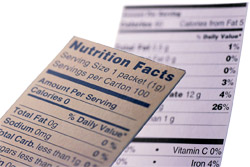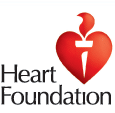- Reading food product labels
- Nutritional information
- Heart Foundation tick of approval
- Packaging language
- Which foods not to pick
- Glycaemic index (GI)
- Picking low GI foods
Reading food product labels
These days, many consumers pick foods depending on the attraction and temptation of the label on the front of the food packaging. However, these labels are often full of marketing hype and can contain misleading claims. To become educated consumers, we should turn to the sides and back of the food product and read the labels carefully. There are many things that the labels can tell us, and we can use these to help us pick nutritious and healthy items.
Nutritional information
Every packaged food provides a list of all the ingredients contained in the food. The ingredients are listed from greatest to smallest quantity.
Serving size and amount per serving
A section of the label, usually located on the side of the container, provides information about the serving sizes of the food. The serving size is a standard measure of the food used for reference on the rest of the label. It is usually expressed in grams or millilitres. The serving size is the amount of the food that the average consumer eats, or that is recommended by the manufacturer.
Note that one manufacturer of a food product may quote ‘x’ number of grams as one serving size, but another manufacturer of the same product may give ‘1.5x’ as a serving size. It is also important to note that the serving size used on food labels is different from the nutritionally recommended serving. For example, the serving size found on the label of a milk carton may be 100 mL, but the nutritionally recommended serving size for dairy is 250 mL.
The servings per container/pack is the number of servings found in the package.
The nutritional information on the label lists the amount of energy (calories/kilojoules), fat, carbohydrates and so on found in the food. When interpreting this list, it is important to note whether the amount is given for the entire contents of the package, for a serving size, or for an arbitrary amount of food (e.g. 100 g or 100 mL).
The nutritional information on a food label provides the amount of energy obtained from the product, expressed in calories or kilojoules. This helps us monitor the amount of fat we consume. It is recommended that no more than 30% of our daily energy comes from fat. Therefore, foods higher in fat should be eaten in smaller amounts.
For our weight to remain stable, the total amount of energy we consume must not exceed the total that we use up through metabolic processes (e.g. exercising, sweating and breathing). Energy intake must match energy output. The average energy intake is about 2800 cal/day for men, and about 1800 cal/day for women. However, these values vary with body size and activity level.

- Sodium or salt: Note that sodium is not the same as salt. The full name for salt is sodium chloride, and sodium is just one part of a salt molecule. To determine how much salt is in the food, multiply the sodium content by 2.5. No recommended daily intake of sodium has been established, but for adults, an adequate intake of sodium is 460–920 mg/day. You should not consume more than 2,300 mg/day of sodium.
- Cholesterol: No upper limit has been set for cholesterol intake, because any increase in cholesterol above zero also increases the risk of coronary heart disease. Cholesterol is unavoidable in most diets, but the recommendation is to consume a low cholesterol diet that is nutritionally adequate.
- Fat: It is recommended that 20–35% of the total energy you receive from food be in the form of fat. Saturated and trans fats together should be limited to no more than 10% of energy. One gram of fat yields about 9 cal. Therefore, the average total fat intake is about 70 g/day for men and 45 g/day for women.
- Carbohydrates: The carbohydrate listed includes complex carbohydrates, starches, non-digestible additives and sugar sweeteners. Carbohydrates should make up about 55% of total energy intake. Carbohydrates should come mainly from low energy density and/or low glycaemic index foods. One gram of carbohydrate yields about 4 cal. Therefore, the average carbohydrate intake is about 380 g/day for men and 245 g/day for women.
- Fibre: The recommended average intake of dietary fibre is 30 g/day for men and 25 g/day for women.
- Protein: The recommended daily intake of protein is 0.84 g/kg body weight/day for men and 0.75 g/kg body weight/day for women. This is roughly 64 g/day for men and 46 g/day for women.
Heart Foundation tick of approval

All food products must comply with strict nutrient standards, which place limits on the amount of unhealthy ingredients contained in the product (e.g. saturated fats, salts). Serving sizes are also monitored. Tick approved meals must contain at least one serving of vegetables, or contain a minimal amount of fibre. Tick approved meals always have a nutritional information panel on the packaging that lists the ingredients that have been tested for in the product.
We must be careful that the Heart Foundation Tick is the real deal – there may be many other “ticks” on the packaging of products that are not necessarily endorsed by the Heart Foundation. Always look for the words “National Heart Foundation Approved” underneath the logo to make sure you are buying truly healthy and nutritious products.
Packaging language
Misleading food packaging is everywhere, often preying on consumers who are seeking the healthiest option or looking to lose weight. It is important to be aware of this and scrutinise claims such as “light“, “low fat” and “lite“. Marketers may use the word ‘light’ to refer to the food’s colour, taste or texture, rather than fat or calories.
Weight loss advertising is all around us, targeting people in the population who are looking for an easy solution. Unfortunately, there is no magic solution for weight loss. We must be careful about buying products claiming to help us lose weight without any effort, exercise or sacrifice. When something seems too good to be true, it probably is. In general, a claim is too good to be true if:
- The product causes substantial weight loss regardless of how much we eat;
- The product causes weight loss for all users;
- Users are able to safely lose more than 1.5 kg per week for more than a month;
- The product promises weight loss of at least 1 kg each week, without having to diet or exercise;
- The product causes permanent weight loss, even when the user stops taking the product;
- The product blocks the absorption of fat or calories; or
- The product causes weight loss by being worn on or over the body, or by being applied onto the skin.
Misleading package labelling has lead the US Food and Drug Administration (FDA) to release a standard set of definitions that food labels must adhere to. Some of the more commonly encountered terms include:
- Light: The food must have half the fat, half the salt or one-third the energy of its regular counterpart. The term can still be used to describe other properties of the food, like colour or texture; however, the label must clearly illustrate this (e.g. “light brown sugar”, “light and creamy”).
- Reduced, less, fewer: To make such as claim, the product must contain at least 25% less of a particular nutrient or calories, compared to the regular product.
- Free, without, zero, no (e.g. fat free, no sugar): To be free of the particular substance, the food must not contain the substance, or must contain it only in neglible amounts. A calorie free food product must have less than five calories per serving. Fat free foods should have less than half a gram of fat per serving.
- Low (e.g. low fat, low salt): May be used to describe products that do not exceed the recommended dietary guidelines for the product. For example:
- Low fat: < 3 g/serving.
- Low cholesterol: < 20 mg/serving
- Low sodium: < 140 mg/serving
- Low calorie: < 40 cal/serving
- Lean: Used to describe the fat content of foods such as poultry, meat and seafood. A serving must have less than 10 g fat, 4.5 g saturated fat, and 95 mg cholesterol.
- Healthy: The food must contain less than 3 g fat and 60 mg cholesterol per serving.
- Good source of: This refers to foods that contain 10–19% of the daily recommended value of a particular nutrient.
- High (e.g. high fibre): The food must contain at least 20% of the daily requirement for the nutrient.
- Fresh: This refers to foods that have not been processed, cooked or frozen (e.g. fresh fruits or vegetables). If a fresh food has been quickly frozen, it can be described as fresh frozen.
Everywhere we look, we see the words “97% fat free” or “low fat” on all sorts of food products. Even foods that never contained any fat may have the words “completely fat free” on them. But if you think that eating so-called “fat free” food will help you lose weight or keep you from gaining weight, then you may be misinformed. Something that is 99% fat free may contain 80% sugar. When we take into account the fat content of a product, we must also be aware of the total energy it contains, the amount of sugars present and the serving size.
The amount of a food that you eat determines the total amount of energy you consume. If you consume more calories than you burn, this results in weight gain.
Different serving sizes for similar products make it difficult to compare the energy and fat content of the two products. In other cases, products that are “low fat” have nearly the same amount of energy as their normal counterpart, because the low fat product may have added suger or artificial flavourings to compensate for the lack of flavour.
These examples highlight the importance of reading the nutritional label on all food products, and not simply being tempted by the claims that the product is “97% fat free”. The nutritional label is able to provide you with accurate information about the total contents of the food product and the size of the serving you should be consuming.

Uncle Tobys fruit roll-ups
An investigation by the ACCC in September 2006 reviewed claims Uncle Tobys Foods had made regarding their fruit roll-ups. These claims included:
- Representations on the packaging and promotional material that the roll-ups were “made with 65% real fruit”;
- Representations on the ingredients panel that the fruit content of the product was equivalent to a specified percentage of fresh fruit; and
- Television advertisements with images of an apple being flattened into a roll-up and an associated description.
Upon reviewing the information provided by Uncle Tobys, the ACCC was concerned that the representations made were likely to mislead or deceive consumers. Uncle Tobys responded by offering to remove or alter the misleading representations by changing the product’s advertising, packaging and ingredients list.
Just Squeezed fruit juices
In March 2006, the ACCC reviewed products from the Just Squeezed Fruit Juices Group, in particular the product labels and the content of fruit juice. The ACCC thought that the prominent placement of the words “Just Squeezed” on the labels, in addition to the images of fruit and the words “orange juice” and “apple juice”, conveyed to the customer that each product was produced directly from the fruit shown on the labels and did not contain reconstituted juice. However, the juices did in fact contain varying portions of reconstituted juice.
In response, Just Squeezed changed the packaging, changing the words “Just Squeezed” to “Just Delicious”, and published an apology in a national newspaper.
Ribena
Ribena has also been under the public scrutiny in recent times, after a claim that its range of products did not contain the advertised amount of vitamin C. The manufacturer, GlaxoSmithKline Australia, conceded that claims about the vitamin C content of Ribena blackcurrant fruit drink products may have misled consumers. The company self-reported the discrepancies to the ACCC, which identified the representations that may have misled consumers:
- Representations on the nutritional information panel of Ribena Ready to Drink fruit drinks that claimed the products contained certain quantities of vitamin C, when in fact they had significantly less vitamin C; and
- Advertising for Ribena fruit drinks that “the blackcurrants in Ribena contain four times the vitamin C of oranges” incorrectly implied that Ribena fruit drinks contained four times the vitamin C of comparable orange juice products.
As a result, GlaxoSmithKline Australia agreed to:
- Only make claims about the vitamin C content of Ribena Ready to Drink fruit drinks if those claims could be substantiated by validated testing methods;
- Stop making any representation that Ribena fruit drinks contain four times the vitamin C of orange juice products;
- Stop making any representation that Ribena fruit drinks contain more vitamin C than orange juice products, unless this can be proven;
- Place a notice in shops selling Ribena fruit drinks advising consumers of the misleading information;
- Publish notices on Ribena websites advising consumers of the misleading information; and
- Review, and make recommended changes to, its trade practices law compliance program.
Which foods not to pick

Fats may be saturated or unsaturated fats – products with a higher amount of unsaturated fat are the more healthy option. High levels of saturated fats have been associated with increased risk of heart disease, type 2 diabetes, obesity and clogging of the arteries. Products which contain high amounts of saturated fats, which should be avoided, include: butter, cheese, and fats on cuts of meat. Whereas it is not possible to consume totally fat free diets (certain fats are essential for health and contain vitamins) we have to monitor the amount of fats that we consume.
Many people consume diets that are high in fats. It is often easy to spot foods which have obvious amounts of fat, such as fat on cuts of meat, deep fried foods and in spreads such as butter, but there is also a lot of hidden fats in foods like pies, cakes, biscuits, burgers and sausages. These foods should be avoided or eaten in moderation, where possible. Checking the labels on these foods and choosing lower fat options will help reduce the total amount of fats consumed. Increased amounts of salt can result in an overall increase in blood pressure, and accumulation of excess amounts of water in the body. Longer-term consequences include an increased risk of stroke and heart disease. You should try and reduce your salt intake by picking low salt foods, or those with no added salt.
Sugars and foods containing added sugar should be consumed in moderation – sugars add calories to our total energy intake, and can also replace foods which provide us with important nutrients. Many foods often contain hidden sugars. For example, we may think we are choosing a healthy option by picking museli bars and cereals to consume during the day. However, some museli bars and cereals contain high amounts of sugar, so it is important to read the labels on the back of foods that usually fit into the healthy category.
Glycaemic index
Glycaemic Index (GI) is a measure of the effect that a carbohydrate containing food has on blood sugar levels, compared to the effect of the same amount of pure sugar, on blood sugar levels. Foods with a low GI (less than 55) means that they cause a slower and lower rise in blood sugar levels. These include: breads such as mixed-grain and fruit and oat breads, barley, pasta, noodles, beans, sweet potatoes, green peas and milk. Foods with a high GI (greater than 70) means that they cause a faster and higher rise in blood sugar levels. High GI foods include: white bread, brown rice, jasmine rice, French fries and coffee. Limiting your intake of high GI foods will help bring down the average GI of your meal and prevent marked surges in blood sugar.
Picking low GI foods
It is recommended that we try to consume foods that have a low GI – apart from a slower and lower rise in blood sugar levels, these foods are often also more healthy and nutritious. If you suffer from diabetes, research has shown that by eating a diet with a lower GI and rich in healthy, nutritious foods, diabetics can reduce their average blood sugar levels. This results in a lowered risk of complications in the long term, such as eye, kidney and nerve damage.
There are many factors that affect the GI of a food. These include: the types of sugar in the food, the way it is prepared, the type of starch, and it’s fat and fibre content. Although you don’t have to avoid all high GI foods, you should try and combine them with low or intermediate GI foods when possible.
More information
 |
For more information on nutrition, including information on types and composition of food, nutrition and people, conditions related to nutrition, and diets and recipes, as well as some useful videos and tools, see Nutrition. |
References
- Ribena vitamin C claims ‘may have misled consumers’ [online]. Canberra, ACT: Australian Competition and Consumer Commission; 21 March 2007 [cited 13 May 2007]. Available from: URL link
- Label interpretation [online]. Barton, ACT: Food Standars Australia New Zealand; 2003 [cited 25 April 2007]. Available from: URL link
- Dwyer J. Nutritional requirements and dietary assessment. In: Braunwald E, Fauci AS, Kasper DL, et al. Harrison’s Principles of Internal Medicine (15th edition). New York: McGraw-Hill Publishing; 2001. [Book]
- Food label [online]. Silver Spring, MD: US Food and Drug Administration; 1999 [cited 26 April 2007]. Available from: URL link
- Healthy eating guidelines [online]. Food Facts; 2006 [cited 18 April 2007]. Available from: URL link
- Longmore JM, Hope RA, Longmore M, et al (eds). Oxford Handbook of Clinical Specialties. Oxford: Oxford University Press; 2001. [Book]
- Eating out with the Heart Foundation Tick [online]. Deakin, ACT: National Heart Foundation of Australia; 2004 [cited 12 May 2007]. Available from: URL link
- Rolled up and squeezed out: ACCC cracks down on food packaging claims [online]. Sydney, NSW: Allens Arthur Robinson; December 2006 [cited 26 April 2007]. Available from: URL link
- Nutrient reference values for Australia and New Zealand [online]. Canberra, ACT: Australian Government National Health and Medical Research Council; 13 December 2006 [cited 27 January 2009]. Available from: URL link
- Dietary reference intakes for energy, carbohydrate, fiber, fat, fatty acids, cholesterol, protein, and amino acids [online]. Washington, DC: National Academy of Sciences; 2005 [cited 12 May 2007]. Available from: URL link
All content and media on the HealthEngine Blog is created and published online for informational purposes only. It is not intended to be a substitute for professional medical advice and should not be relied on as health or personal advice. Always seek the guidance of your doctor or other qualified health professional with any questions you may have regarding your health or a medical condition. Never disregard the advice of a medical professional, or delay in seeking it because of something you have read on this Website. If you think you may have a medical emergency, call your doctor, go to the nearest hospital emergency department, or call the emergency services immediately.







